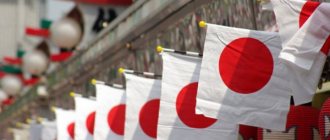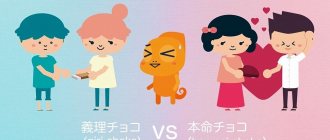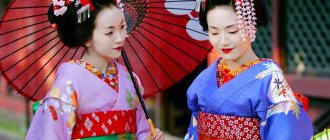Coming of Age Day in Japan
Coming of age day is a significant date in the life of every person. Even yesterday's teenager, upon reaching a certain age, becomes a full member of society and the state. From this time on, he has additional rights and responsibilities. In every country and family this day is celebrated differently, but in Japan this holiday has been elevated to the rank of a national holiday.
This Japanese public holiday was officially established in 1948. The purpose of the holiday is to congratulate and encourage people who have reached adulthood; the holiday helps yesterday's teenagers understand that they are already adults. Previously, the date of celebration was set on January 15, but since 2000. Seijin no Hi Coming of Age Day began to be held annually on the second Monday of January.
In Japan, the day of majority since 1876 is considered the day of turning 20 years old.
The origins of the coming-of-age celebration go back to at least 714, when a young prince had his hairstyle changed from a child to an adult, dressed in adult clothes, and given a name change, thereby marking his entry into a new adult life. In ancient times, the ceremony of entry into adulthood was carried out only for noble families and the samurai class; subsequently, this tradition began to be performed by commoners. The ceremony of transition to adulthood itself is called genpuku. During the Edo period, boys had their hair shaved off their foreheads and tied the rest into a braid. The age at which boys entered adulthood was different and ranged from 12 to 16 years.
Girls in ancient Japan had their own ritual of transition to adulthood, it was called mogi (literally putting on a dress) and this happened at the age of 12-14. From that time on, they became adults and could get married and bear all the responsibilities of adult life.
Let's go back to today. Coming of Age Day is celebrated by everyone who reached the age of 20 in the previous year, but today 19-year-olds also take part in the holiday if their 20th birthday occurs before April 1 of the current year.
This holiday is important not only for yesterday’s children, but also for adults and parents, and therefore they begin to prepare for it long before it begins.
For 20-year-old citizens of the country, local authorities prepare festive and festive ceremonies and parties and provide them with alcoholic beverages, as this is considered a privilege for adults. It is from the age of 20 that a Japanese can work, vote in elections and be elected, and it is emphasized that from this age Japanese youth are officially allowed to drink alcohol and smoke. What do they not deny themselves on this holiday?
But Coming of Age Day begins piously with ceremonial events, meetings and gatherings. The heroes of the occasion are invited to official events by local authorities or schools; almost 80% of those invited take part in the celebration. At the official part, teenagers listen to congratulations and parting words from local authorities, influential businessmen, politicians and actors, round tables and conversations are held with the mayor. Children who grow up receive symbolic gifts.
On this day it is also customary to go to temples, offering thanks to the gods. But in fairness, it should be noted that today’s youth do not always strictly adhere to traditions and the influence of the West has had a big role on their worldview, including religiosity.
On this day, girls are more beautiful and elegant than ever. They wear colorful winter kimonos, with long sleeves (furisode) with a mandatory fur cape, since the celebration takes place in the coldest time of the year, and traditional zori shoes.
A kimono today is not an attribute of a modern girl, but on her coming of age it is a must. The cost of a kimono can reach $10,000. Not every family can afford to buy such an expensive outfit, but this is only part of the cost, and you will also need shoes, an obi belt, a snow-white fluffy scarf-cape, a small handbag, a chic hairstyle and an indispensable attribute of coming of age - a photograph. Therefore, parents prepare for this holiday long ago and collect money. It is believed that for girls, a festive outfit on this day is correlated with the cost of an expensive car.
Shops engaged in sewing and renting kimonos receive a third of their annual income thanks to this day. So in Tokyo, renting a kimono for 1 day costs $1,000; in small cities the cost is correspondingly lower. Hairdressers and photo studios work intensely on this day and increase their staff several times to cope with the flow of people wanting to take pictures of themselves. These portraits are always hung at home as a memory of one’s coming of age.
Boys wear black European suits, but there are also those who wear a traditional kimono with hakama to celebrate their coming of age.
After the ceremonial events, young people continue to have fun on their own in bars, karaoke and other entertainment venues. They often come home in the morning and often with outside help, but on this day everything is allowed and even if someone has had too much, it is not considered shameful. Tomorrow their adult life will begin, and today is a holiday.
Coming of age celebration in Japan. Seijin-shiki
The second Monday of January marks Coming of Age Day (成人の日 Seijin no Hi). It is a public holiday, but is not considered an ancient event. It was first introduced in 1948. From 1948 to 2000, it was celebrated on January 15th. When the Japanese government introduced the Happy Monday system in 2000, it was then changed to the second Monday of January.
Seijin-shiki (成人式) or coming-of-age ceremonies are held by local authorities throughout Japan to commemorate the day of coming of age. Coming of age ceremonies have been celebrated in Japan since at least 714 AD. It is now carried out in local or prefectural offices. Young people living in the area and who turned 20 years old between April last year and April this year are invited to the ceremony. Foreigners who fall into these categories are also invited.
Distribution of household responsibilities among working Japanese couples.
Twenty years is the legal age in Japan. This is considered a big turning point because once a Japanese person reaches twenty years of age, they officially become an adult. This means that not only does your freedom increase, but your responsibility also increases.
Unlike any other day, government offices are full of young people. Most of them come to the ceremony with their parents. The girl who attends the ceremony usually wears a furisode, a style of kimono distinguished by its long sleeves. Furisode is worn by unmarried women and is the most formal type of kimono. Wearing furisode symbolizes that a woman is unmarried and of age, and therefore available for marriage. They also wear zori sandals, traditional Japanese flat sandals.
Makeup and special hairstyle are mandatory. Most girls tie their hair up and wear a few artificial flowers. Meanwhile, most men wear Western suits and ties. But some of them wear a male-style kimono called a hakama.
Japanese alcoholics' complaint of 1559.
The ceremony is a good occasion to chat with your old friends. As the young people meet with friends, the atmosphere before the ceremony is reminiscent of a school reunion. They say hello, talk a lot and take pictures. The main thing is to take a lot of photos, especially for girls.
The event during the coming of age ceremony is usually very different from each region. The ceremony usually includes speeches by prominent figures. Some regions may also host traditional and cultural performances. At the end of the ceremony they give out small gifts and flowers. In addition to attending the ceremony, young people should visit a local shrine with their families. After the meetings, they celebrate reaching legal age by drinking alcohol at an izakaya with their friends.
Types of restaurants and their price ranges. Japan
Views: 742
Share link:
- Tweet
- Share posts on Tumblr
- Telegram
- More
- by email
- Seal
Liked this:
Like
Similar
How is Coming of Age Day celebrated in Japan?
Japan's national holiday, Coming of Age Day, was celebrated in Tokyo. Traditionally, it is celebrated on the second Monday of January. On this day, they are invited to district and municipal departments, where the heads of administrations give them instructions on “how to behave in adulthood.”
The age of majority in Japan is reached at the age of 20; from this moment on, local residents have the right to vote, purchase and consume alcoholic beverages, engage in real estate transactions, and much more that was not previously permitted.
1) In Japan, people who have turned 20 in the past year are celebrated as coming of age. (AP)
2) Until the mid-19th century, Japanese boys and girls became adults at different times. (AP)
3) Previously, girls, with the help of their elders, put on an adult-cut kimono for the first time, blackened their teeth, and shaved their eyebrows. (AP)
4) Boys had their locks above their forehead shaved and braided (eboshi, the hairstyle of an adult man). At the same time, he changed his child's name to an adult one. (AP)
5) This ceremony was called mogi. Upon completion, boys and girls were considered adults and could marry. (AP)
6) Since 1876, the age of majority by the Japanese government has been set at 20 years old, but the official holiday was established only in 1948, and until 2000 it was celebrated on January 15. (Koichi Kamoshida/Getty Images)
7) Since 2000, it has been moved to the second Monday of January, thus giving three days off in a row. (AP)
On this day, the heads of local administrations hold seijin shiki - an official ceremony for newly-minted adults. At it, young men and women are congratulated by politicians and local celebrities, who give farewell speeches, remind them of civic duty, new rights and responsibilities, and give gifts. (Koichi Kamoshida/Getty Images)
9) Traditionally, 20-year-old celebrants visit a temple where they pray to the gods and make wishes. At the Meiji Shrine, a momote shiki, an archer ritual, is held in their honor, which is opened by two priests dressed in white. They shoot two blunt arrows that make a whistling sound in flight. After them, brightly dressed archers shoot arrows. (AP)
10) After all the ceremonies, rituals and lectures for students, the celebration ends in bars, restaurants or karaoke. (AP)
11) And this year, some Tokyo girls decided to celebrate coming of age at Disneyland. (AP)
12) Japanese women celebrating their coming of age wear expensive winter kimonos of a special cut with long sleeves - furisode. (Koichi Kamoshida/Getty Images)
13) Other components of the costume are a fur cape, an obi belt, which is tied with a special knot, traditional zori slippers and a small handbag containing perfume and cosmetics. (Koichi Kamoshida/Getty Images)
14) The costs of such an outfit are comparable to buying a new car, so preparations for the holiday begin several years in advance, or they rent a kimono. (Koichi Kamoshida/Getty Images)
15) On this day, young men dress in a European suit, or in a traditional men's kimono and haori jacket. (Koichi Kamoshida/Getty Images)
16) Since at present in Japan European clothing has practically replaced traditional clothing from daily use, the purchased kimono is then almost never used. In many families it is inherited. (Koichi Kamoshida/Getty Images)
17) Even 20-30 years ago, this ritual caused sharp rejection among young people, among whom left-wing ideas were very popular in those days, and everything that came from the government, without exception, was perceived as “reactionary.” (Koichi Kamoshida/Getty Images)
18) According to the recollections of contemporaries, at that time young people who decided to come to the municipal offices for the holiday were subjected to ridicule and ostracism. (Koichi Kamoshida/Getty Images)
19) In cities, the number of participants in official ceremonies was extremely small, but in rural areas traditions (and discipline) were stronger. (Koichi Kamoshida/Getty Images)
20) Today, the majority of the Japanese population is quite apolitical and free from any ideology, and this holiday has turned into an additional day off for the vast majority. (Koichi Kamoshida/Getty Images)
21) Perhaps, those directly interested in the coming of age celebration are young girls who have reached the age of 20. For them, this is a reason to show off, walking with their girlfriends to the district government and back in a beautiful traditional outfit. (Koichi Kamoshida/Getty Images)
22) Since the holiday is held in mid-January, when it is quite cool in Tokyo, in the last few years it has become especially fashionable among girls to wear luxurious fur coats over their shoulders over a kimono. (AFP PHOTO/Yoshikazu TSUNO)
Source: https://bigpicture.ru/?p=28160











